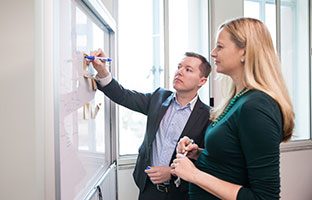Get the most of Squiz CMS with an effective training program
- Read time: 5 mins
- Tech level: low
- Key point: Better content and branding are some of the benefits of CMS training

A website is only as good as the people that maintain it. Similar to how a large garden needs regular tender loving care, continual upkeep and maintenance are needed for large websites.
This article walks you through why website CMS training is essential to an efficient web publishing process that results in quality web content.
Effective web training leads to:
- cost savings through a more efficient updating process
- content that's accurate and up to date
- and branding that’s better and more consistent.

New CMS features
Training is a great opportunity for web editors to learn about the new features of a CMS. It’s common in large organisations for the full potential of a CMS not to be realised.
Over time, upgrades bring a lot of new benefits and improvements in the form of new CMS features and enhancements of existing features.
An example is the ‘Compare to Live’ feature of Squiz CMS. There are likely many editors around Australia and around the world that are unaware of how useful this feature is - and this is just one of the many useful features of Squiz CMS.
If just one new CMS features improve productivity, then in some cases the training has already paid for itself.

Improved productivity
The cost of training has a real financial return in the form of productivity. Productivity is important, especially for large organisations where even a 2% increase in productivity can equate to large sums of money.
Teams that are well trained can complete their tasks faster and more accurately.
CMS training help with your talent retention
Workplace training is important when a company wants to demonstrate its commitment
People get paid in two currencies – money and job satisfaction. Research has shown that training is a very effective demonstration that a company is committed to the further development of their staff.
Better processes
Good website training goes beyond the technical side of maintaining websites.
Usability and accessibility should also be included in an effective website training program. When Polished Pixels trains website editors, we weave in relevant content that help editors think about the people that will actually be using the webpages that the editors are responsible for.
Training reduces risk and breaks silos
Training spreads the knowledge around to more people and reduces the risk of silos.
A common situation in large organisations is for a high amount of knowledge to sit in a single person’s head. This is a risky situation because if that person goes on unexpected leave, then the website production process could slow down.

The process of training
Generic training can only take an organisation so far. The best results come when a training package has been created to suit the specific goals and people of your organisation.
From our experience, this is a very effective way of achieving the goals of your training.
Step 1: Analyses
It’s really important that training results in achieving the strategic goals of the training package.
When Polished Pixels is preparing a CMS training package, we start my spending half a day at the business. We use this time to:
- Get to know the key people
- Talk to managers (including HR managers) and team members
- Review your technical set up
- Identify the skill gaps
- Find processes that could be streamlined by training.
Step 2: Development of a training package
Experience counts in this step because the training really needs to be linked to your specific needs.
When Polished Pixels develops a training package, we cater to the availability and learning styles of your website editors. We offer a variety of mediums including:
- In-person seminar style training
- In-person follow up training
- Online videos
- Detailed tutorials
- And online Quiz’s
Step 3: testing
Once we’ve put together your training package, you can try it yourself to confirm that it’s what you were expecting. We then listen carefully to your feedback and if changes are needed, we promptly revise the training material.
Once approved, we create a roll-out schedule and we recommend that it’s on small groups only.
Step 4: Continual improvement
It’s a good idea for trainees to complete a quiz at the end of the training to confirm that everything was understood. The test results can be fed back into the improvement process so if a particular concept was consistently not understood, the training material for that concept can be reviewed and tweaked.
Getting feedback from trainees on their training experience is also important so that can continually tailor the training to the specific needs of your organisation.
Step 5: checking-in
It’s important for the goals of the training actually get met, so when Polished Pixels develops a training module, we finish with meeting with the project stakeholders.
- Did we solve the problem?
- Has there been a noticeable decrease in support requests?
- Has there been a reduction in frustration?
- Has there been an improvement in productivity
- Has the quality of the website content improved?
These are just some of the questions we ask during the post-implementation meeting.
More information on CMS training
Developing a CMS training program then regularly holding training sessions is very time consuming.
Polished Pixels has developed custom training packages for large organisations such as Macquarie University and IOOF.
Ask us how we can improve your websites by upskilling your website editors.











